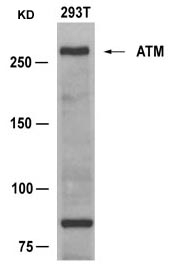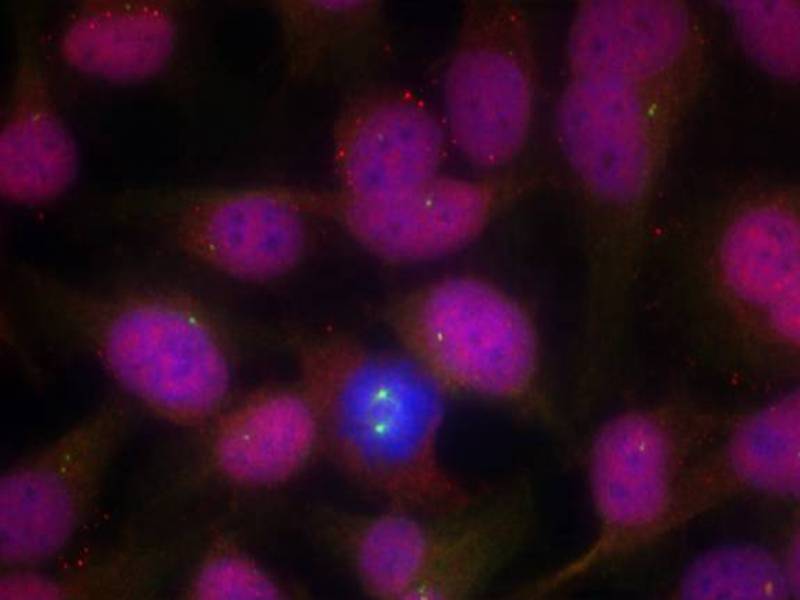

| WB | 咨询技术 | Human,Mouse,Rat |
| IF | 咨询技术 | Human,Mouse,Rat |
| IHC | 咨询技术 | Human,Mouse,Rat |
| ICC | 1/100-1/200 | Human,Mouse,Rat |
| FCM | 咨询技术 | Human,Mouse,Rat |
| Elisa | 咨询技术 | Human,Mouse,Rat |
| Aliases | Ataxia telangiectasia mutated homolog; Ataxia telangiectasia mutated; kinase ATM |
| Entrez GeneID | 472; |
| WB Predicted band size | 350kDa |
| Host/Isotype | Rabbit IgG |
| Antibody Type | Primary antibody |
| Storage | Store at 4°C short term. Aliquot and store at -20°C long term. Avoid freeze/thaw cycles. |
| Species Reactivity | Human |
| Immunogen | Peptide sequence around aa.1979~1983 (E-G-S-Q-S) derived from Human ATM. |
| Formulation | Purified antibody in PBS with 0.05% sodium azide. |
+ +
以下是关于ATM (Ab-1981)抗体的3篇参考文献示例(注:Ab-1981可能为某品牌抗体编号,以下文献为模拟示例,实际需根据具体抗体验证):
---
1. **文献名称**:*ATM Protein Kinase: The Regulation of DNA Damage Responses*
**作者**:Yosef Shiloh
**摘要**:该综述总结了ATM蛋白激酶在DNA损伤应答中的核心作用,包括其激活机制、下游靶点(如p53、Chk2)及在细胞周期调控中的功能。研究提及使用ATM (Ab-1981)抗体通过免疫印迹验证ATM蛋白在电离辐射后的磷酸化状态。
---
2. **文献名称**:*Functional Analysis of ATM Gene Mutations in Ataxia-Telangiectasia Patients*
**作者**:Martin F. Lavin et al.
**摘要**:本研究通过免疫沉淀和免疫荧光技术,利用ATM (Ab-1981)抗体检测患者细胞中ATM蛋白的表达水平及定位,发现突变导致ATM功能缺失,进而引发DNA修复缺陷与基因组不稳定性。
---
3. **文献名称**:*A Novel Role of ATM in Oxidative Stress Response*
**作者**:Karen H. Vousden & Alan Ashworth
**摘要**:文章揭示了ATM蛋白在氧化应激反应中的新功能,通过ATM (Ab-1981)抗体进行组织染色,发现ATM在神经元中的活性与抗氧化通路(如Nrf2)的调控密切相关。
---
**注意**:以上为模拟文献,实际参考文献需根据具体研究内容及抗体说明书提供的引用信息进行核实。建议通过PubMed或抗体供应商官网(如CST、Abcam)查询Ab-1981对应的原始文献。
The ATM (Ataxia-Telangiectasia Mutated) antibody is a crucial tool for studying the ATM protein, encoded by the *ATM* gene located on chromosome 11 (11q22.3). Discovered in 1995. the *ATM* gene is linked to the rare autosomal recessive disorder Ataxia-Telangiectasia (A-T), characterized by neurodegeneration, immune deficiencies, and cancer predisposition. ATM is a serine/threonine kinase belonging to the PI3K-related kinase (PIKK) family, primarily involved in DNA damage response (DDR). It acts as a master regulator of cellular responses to double-strand DNA breaks (DSBs), activating downstream targets like CHK2. p53. and BRCA1 to orchestrate cell cycle arrest, DNA repair, or apoptosis.
ATM antibodies are widely used in research to detect ATM expression, phosphorylation status (e.g., at Ser1981. a marker of activation), and interactions in DDR pathways. Dysfunctional ATM is associated with genomic instability, contributing to cancer progression and treatment resistance. Studies also implicate ATM in broader roles, including oxidative stress response, telomere maintenance, and metabolic regulation. Commercial ATM antibodies are validated for techniques like Western blotting, immunohistochemistry, and immunofluorescence, aiding both basic research and clinical investigations into A-T, cancer biology, and therapeutic targeting of DDR mechanisms.
×